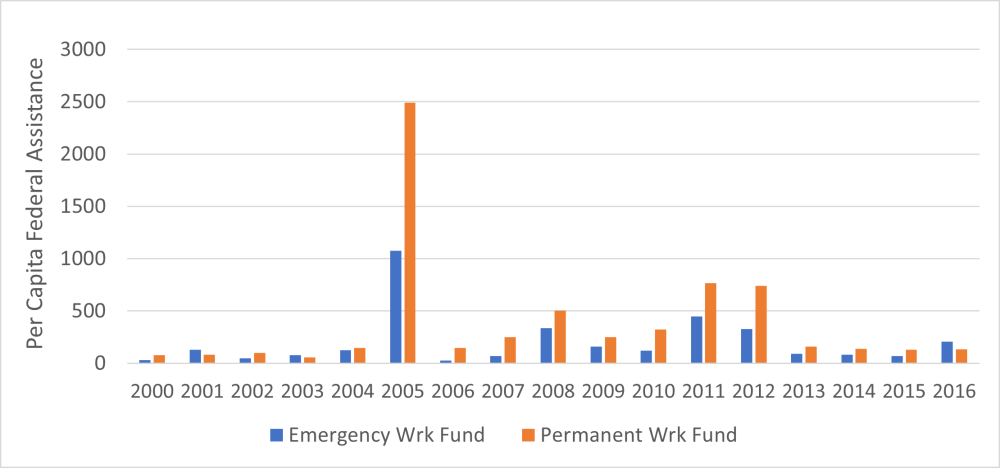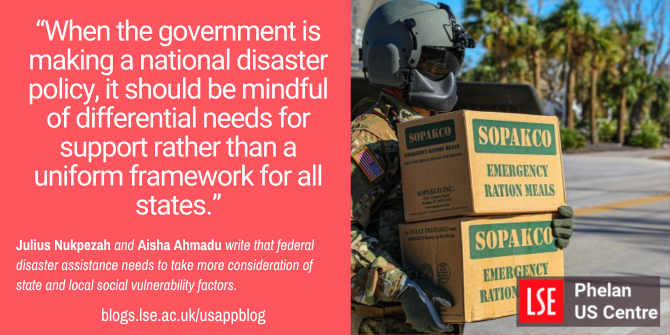
 Every year the United States experiences an average of 60 disaster events, which have caused more than $1.7 trillion in economic losses over the past 40 years. When disasters overwhelm the ability of state and local governments to respond, the federal government will step in to provide monetary assistance. Julius Nukpezah and Aisha Ahmadu look at how this federal subsidiary assistance to states is influenced by social vulnerability factors like income, race, and education. They find that the influence of these factors raises social equity concerns about disaster response and federal grant policies.
Every year the United States experiences an average of 60 disaster events, which have caused more than $1.7 trillion in economic losses over the past 40 years. When disasters overwhelm the ability of state and local governments to respond, the federal government will step in to provide monetary assistance. Julius Nukpezah and Aisha Ahmadu look at how this federal subsidiary assistance to states is influenced by social vulnerability factors like income, race, and education. They find that the influence of these factors raises social equity concerns about disaster response and federal grant policies.
Federal subsidiarity assistance to states
The subsidiarity principle – the idea that policy issues should be dealt with at the level of government best placed to address them – provides a framework for resolving challenges within a multilayered federal system like the United States. This principle is helpful as US states and local governments face inadequacies that often mean that the national government needs to intervene. All assistance from the federal government to subnational governments is appropriately described as subsidiarity assistance. These include public assistance grants and intergovernmental transfers designed to address distinct needs. While public assistance grants fund disaster related permanent work and emergency work at the state and local levels, intergovernmental transfers provide general funding for a wide range of programs and services. The federal government allocates billions of dollars in grants annually to support a wide array of services provided by states and local governments. Figure 1 shows federal funding for emergency works and permanent work following disasters since 2000.
Figure 1 – Federal Assistance to Subnational Governments

What influences federal subsidiarity assistance to states?
The unequal impact of disasters and social vulnerability across the states likely have effects on how the federal government allocates funding to states. Available data show that the US experiences an average of 60 major disaster events every year. Over the last forty years, these have caused more than $1.7 trillion in economic losses. Disasters impact supply chains and halt the supply of essential public services. Disasters also result in business closures and force businesses to defer planned commercial activities, limit household mobility, affect tourism, and impact expected revenue from commercial and consumption activities. Disasters destroy utility services, road networks, and buildings, and potentially weaken unprepared communities, making them more financially vulnerable. The occurrence of a disaster may justify federal intervention to return jurisdictions to normalcy.
In the US, the 1988 Stafford Act allows for a presidential disaster declaration if a significant disaster occurs which overwhelms the capability of a state or local government to respond and recover and therefore, requires federal intervention to supplement existing resources to ensure public safety and preserve life and property. Disaster declarations may be classified as major disaster declaration, emergency declaration, and fire disaster.
Figure 2 – Disaster Declarations 2000 – 2016

Besides disasters, states differ regarding their social vulnerability. Social vulnerability assumes that the presence of certain risk factors influences a community or group’s susceptibility and governs their ability to access resources. Socio-economic vulnerability factors (e.g., income and tax revenues) and socio-demographic factors (e.g., race and education) affect access to financial resources necessary for economic development and the ability to absorb external shocks. These differences make some communities more susceptible to harm, causing human suffering, low economic productivity, and limited access to beneficial resources.
The importance of social vulnerability factors in disaster assistance
Our analysis of data from 50 US states over a 17-year period shows that external risk events associated with disasters and internal social vulnerability factors of states influence federal subsidiarity assistance to subnational US state governments. Federal subsidiarity assistance to states is tailored strategically to aid where it results in the greatest improvement. Utilizing the subsidiarity principle ensures that resources are re-distributed to those segments of the population that are in dire need of them.
Although disaster-induced public assistance grants and intergovernmental transfers are both federal subsidiarity assistance programs, each is administered to address different needs. The federal government’s subsidiarity assistance program addresses social vulnerability concerns to produce social equity outcomes for states using intergovernmental transfers. However, recognizing the differential impacts of disasters on states, it provides public assistance grants to augment the efforts of state and local governments dealing with disasters.

“Florida National Guard” (CC BY 2.0) by The National Guard
Federal assistance often goes to better off areas.
But, of concern is that federal dollars tend to be channeled to privileged jurisdictions rather than economically vulnerable communities. It could be that poorer states may not be reporting damages at a magnitude that measures up to the disaster threshold to warrant federal support. With a few exceptions, the federal government uses a 75/25 cost-sharing rule where every 75 dollars from the federal government award is complemented with 25 dollars from the requesting government. Could it be that poorer governments lack a matching fund and hence make fewer requests to the federal government?
On the other hand, affluent communities may be receiving more resources to aid in infrastructure rehabilitation due to greater damage to public facilities and buildings. This means poor communities could become poorer and thereby widening the poverty and inequality gap. The federal government is often obligated to support the recovery efforts of fiscally well-endowed states because of their economic significance to the US.
Nonetheless, federal government funds are better distributed by tailoring grant programs to specific jurisdictional needs rather than a one-size-fits-all approach. Subsidiarity assistance addresses the limits of one-size-fits-all and contributes to policy diversity in a federation. Because states are part of a federal system, the national government intervenes when they are overwhelmed by catastrophic events, such as disasters. Similarly, the federal government responds to social and economic differences with its re-distributive policy that tailors assistance to needs rather than generic assistance that assumes state challenges could be addressed with a one-size-fits-all national policy.
By utilizing the subsidiarity principle, the federal government empowers states with supplemental resources to perform their functions in emergency actions and social protection effectively. Subnational governments are relatively limited by the fiscal resources they can raise to address unpredictable events. As the frequency of hazard events and social vulnerability increases, extra assistance from the federal government to states assists in rapid recovery, and social response increases.
Practical lessons for policymaking
When the government is making a national disaster policy, it should be mindful of differential needs for support rather than a uniform framework for all states. Also, there is a need to focus on social equity outcomes in policymaking and the distribution of public aid. Federal policymakers should develop equity-conscious approaches in formulating compensatory policies so that states that experience more disaster events and economic inequality would receive extra financial support. Because disasters have more adverse effects on vulnerable communities, compensatory policies should be grounded in social equity to serve public interests. This could be done by codifying social equity principles into the distribution strategies of aid programs so that vulnerable communities equally at risk would likely benefit from such resources.
- This article is based on the paper, “Disasters and Social Vulnerability Determinants of Federal Subsidiarity Assistance”, in Public Administration Review.
- Please read our comments policy before commenting.
- Note: This article gives the views of the authors, and not the position of USAPP – American Politics and Policy, nor the London School of Economics.
- Shortened URL for this post: https://bit.ly/3tZQh4q






